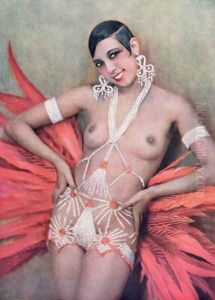Walery, Stanislas Paintings
Stanislas Julien Walery was a French photographer, better known as simply 'Walery,' who gained considerable fame for his portraits of high society and the Parisian elite during the late 19th and early 20th centuries. Born Stanislas Julien Walery on October 30, 1863, in Warsaw, Poland, which at the time was part of the Russian Empire, he later moved to Paris, where he would establish himself and become an influential figure in the artistic circles of the time.
Walery is particularly known for his work during the Belle Époque, a period characterized by optimism, regional peace, economic prosperity, and technological, scientific, and cultural innovations. He was a contemporary of other great photographers of the day, such as Nadar and Eugène Atget. Walery's photographs stand out for their high quality and the artistry with which he captured his subjects, often employing soft-focus techniques that were innovative at the time and contributed to the ethereal and elegant aesthetic of his portraits.
In Paris, Walery opened a photographic studio on the prestigious Rue de Londres. He became famous for his portraits of celebrities, including renowned figures from the worlds of art, literature, and entertainment. Among his notable works are the portraits of dancer and actress Loïe Fuller, whose serpentine dance captivated audiences, and the images of the infamous courtesan and actress Liane de Pougy. Walery's photographs were also published in magazines and on postcards, which was a popular means of disseminating images during that era.
Perhaps one of Walery's most significant contributions to photography was his series of nudes, 'Études de Nu,' which were published in a limited edition portfolio in the early 20th century. This work was considered daring for the period and showcased his ability to handle the human form with sensitivity and grace, capturing the beauty and sensuality of his models.
Walery's influence extended beyond photography. He was also known for his involvement in the development of early cinema. His interest in the moving image led him to work with the Lumière brothers, who were the pioneers of motion picture technology.
Stanislas Walery's career continued to flourish until his death in Paris on February 12, 1935. His legacy lives on through his elegant and sophisticated portraits, which remain a testament to his skill as a photographer and his unique ability to capture the spirit of the Belle Époque. His works are preserved in various institutions and private collections, serving as valuable historical documents of an era defined by its artistic and cultural dynamism.


